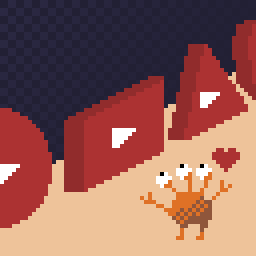
Sundry Sunday is our weekly feature of fun gaming culture finds and videos, from across the years and even decades.
Presented without comment (1 1/2 minutes).
The Flipside of Gaming

Sundry Sunday is our weekly feature of fun gaming culture finds and videos, from across the years and even decades.
Presented without comment (1 1/2 minutes).
Super Mario 64 has 120 Stars to collect, 90 of them from individual named missions in the game’s 15 courses. Many players find that a fairly early one, Snowman’s Lost His Head in Course 4, Cool Cool Mountain, is among the most vexing. When I played it, I found it a illustrative example of what happens when the game gives you imprecise directions, and just asks you to try. I did try, time after time, until it just seemed to work, for some reason I couldn’t figure figure out, and by that point I was just happy to be done with it.
Cool Cool Mountain is a big area with sloped paths leading from the top leading to the bottom. For this Star, some ways up there’s a snowball that talks to you, asking if you could lead it to its body, a larger snowball, some ways down. As it rolls it grows in size. Ideally you stay ahead of it the whole way, and managed to get it to crash into its body. If this happens, it spawns a Star; if it doesn’t, then it doesn’t appear, leaving you to exit the course from the pause button or collect a different star before trying again.
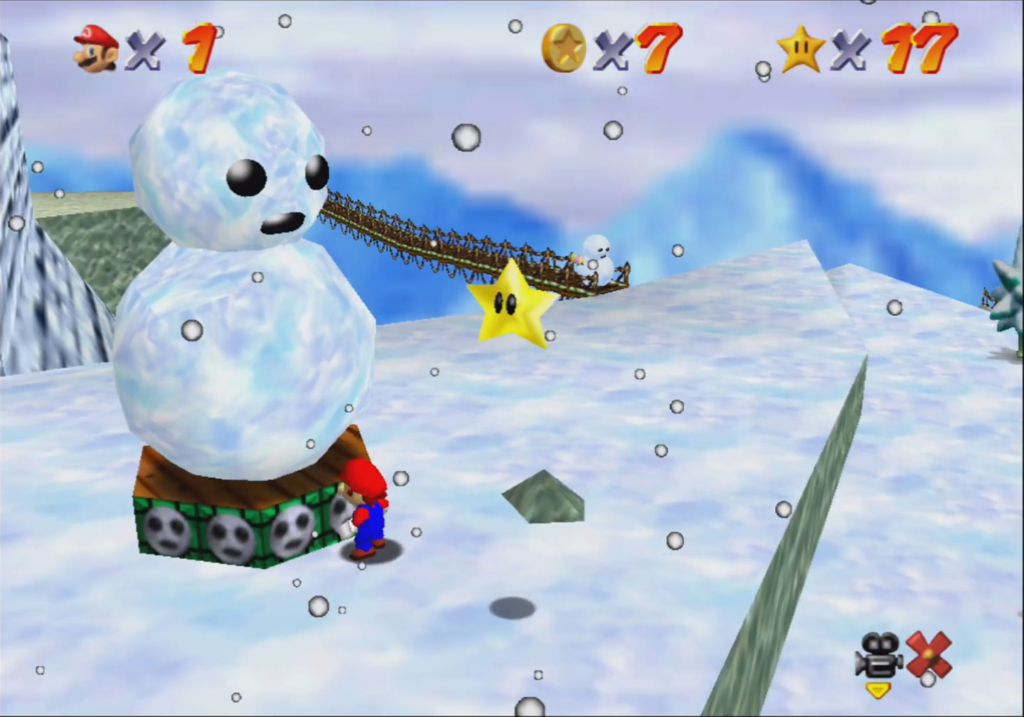
The problem is, you can do exactly what I explained and the snowhead still won’t collide with the snowbody. Sometimes the head seems to aim at your position near the end of its route, but sometimes it doesn’t, and even when it does, you have to be standing in a narrow region in order for it to produce the necessary impact.
As it turns out there’s three requirements. Kaze Emanuar broke them down in a two-minute Youtube video last year. It’s pretty short as far as these videos go!
The requirements are:
The thing is, to a player, it looks like you’re only really needed at the end of the route. Why do you have to hit the sphere first? Even if you manage to stay ahead off the snowball the whole way, if you don’t touch the completely invisible sphere, the whole thing will break. And since it’s on a bridge, it looks like it should be fine to take a shortcut off onto the lower path.
Further, you have to be both within the cone and in a place where the snowball will collide with the body. There are many places you can stand that would direct the snowball to hit the body, but aren’t in the cone! The cone is also invisible, and the range off places you can stand to complete it is quite narrow.
Watch the video for the full details, it’s really short! Kaze does a good job of explaining it.
In 24 minutes, Bismuth on Youtube explains how Super Mario 64 was beaten without a single A button press, on actual hardware by someone who’s nom de net is Marbler. The run was performed over five days. Video of the feat isn’t up yet, but should appear on Marbler’s channel when uploaded and encoded. Here is the video embed:
I have some commentary on this. First, if you’ve been following PannenKoek all this time like I have you know they’ve done many videos over the internals of SM64, many with the end goal of getting the A Button Challenge as low as it can go. The answer is, he doesn’t get all the stars, and it’s been a long iterative process of routing, and figuring out how to do formerly TAS-only techniques on with a controller. After a long period of improvement, finally, the dam broke.
What does this mean for PannenKoek? I think their most interesting videos lately have been those that are more about Mario 64’s internals, like that terrific explainer about invisible walls. And completing every star without A button presses is still a ways off. I think they’ll be fine.
How Super Mario 64 was beaten without the A button (Youtube, 24 minutes)
You may remember PannenKoek as that person who has been trying to figure out how to complete Super Mario 64 in as few A button presses as possible, an odd, but no less noble, quest. They’ve been at it for quite a long time now, 13 years, but they’re still going. They have two loaded Youtube channels containing the pixelated fruits of their labors, PannenKoek2012 and UncommentatedPannen. Whenever you see a random Youtube video that uses the File Select music from Super Mario 64 as background music, they’re paying homage to PannenKoek, god of the game explainers.
While explaining aspects of Mario 64, that foundational, primordial 3D platformer, sometimes they ably explain complex and niche topics in computer science along the way. We’ve covered their videos before, more than once probably, and marveled at how by explaining some unexpected behavior in Nintendo’s N64 launch title, they have managed to make something important about how computers do things comprehensible. In three videos, they explained how Mario 64 handles terrain well enough that one feels (somewhat misguidedly) that they could implement their own 3D platformer. They made a bizarrely interesting video about how characters blink their eyes that shows various ways that games implement timers and randomness. They have a whole video on pseudorandom number generation, and another on floats, that computer number representation system that has deeply weird implications.
Their most recent video is a three hour, 45 minute epic that explains why sometimes, when Mario jumps, he seems to strike something invisible in his way. It’s a consequence of several unusual decisions Nintendo made in constructing the physics of Mario’s world, which includes the fact that level edge walls in Mario 64 aren’t implemented as geometry, but as a consequence of the lack of geometry: if there is no floor over a space, then the game rules it as Out Of Bounds. It won’t let Mario enter this completely invisible unspace under normal conditions, and will instantly kill him if he somehow enters into it. It is like antimatter. And that’s not even getting into how ceilings operate.
Here, then, it is. It is a lot, and I wouldn’t blame you if you can’t get through it all, but for a certain intersection of game obsession and brain chemistry, it is engrossing, and that’s before they even get to the periodic table of invisible walls:

On Romhack Thursdays, we bring you interesting finds from the world of game modifications.
It’s another video! And it’s Nintendo related! I bet you’re just thrilled!
This is one, however, is far from something the Big N would approve of. Snooplax goes into great detail in explaining the history of hacking Super Mario 64, the first 3D game to really have a substantial hacking scene–I don’t count things like DOOM, since to a degree it was made to be extensible. Nintendo never dreamed that people would do the things to the Mario 64 engine that they have, which has included optimizing it to the extent that it can run at 60 fps on original hardware!
Seeing all these hacks together in one video is rather inspiring. There’s been not one, but at least three, major Super Mario 64 level editors, with different degrees of flexibility and detail. What enthusiasts have done with the engine over the years is surprising, and there’s no end in sight, so please enjoy this look back at this prolific scene.
History of SM64 Rom Hacks (Youtube, 37 minutes)
I’ve mentioned Kaze Emanuar’s efforts to make the best Mario 64 there can possibly be on its native hardware. He’s compiled it with optimization flags turned on, made its platforming engine much more efficient, and worked hard to minimize cache misses, which was a major source of slowdowns in the game’s code. Under his efforts, he’s gotten the engine running at 60fps (although not yet in a playable version of the original). While these optimizations are not the kind of thing that can keep being found indefinitely, he’s bound to run out of ways to tune up the code, currently he’s still finding new ways to speed it up.
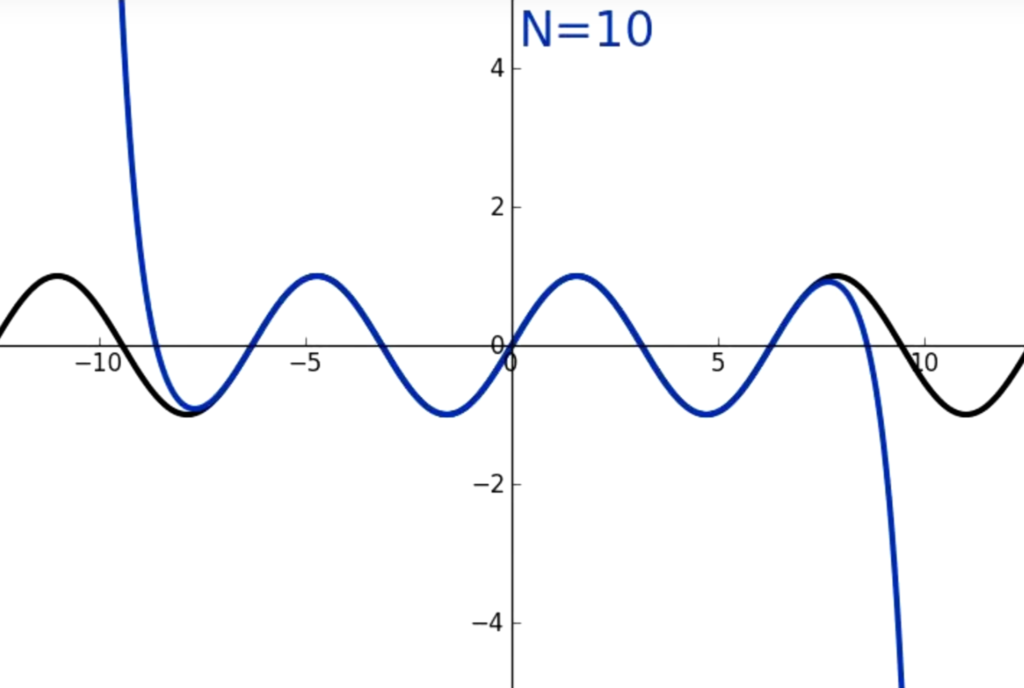
He made a Youtube video detailing his most recent optimization find: getting the game’s trigonometric functions executing at their speediest. What is interesting is that the Mario 64 code already uses a couple of tricks to get sine and cosine results in a rapid manner: the game only uses 4096 discrete angles of movement direction, and contains a lookup table that covers each of those angles. But it turns out that this optimization is actually a mis-optimization, because the RAM bus hits incurred to read the values into the cache are actually more expensive than just figuring out the values in code on the N64’s hardware!
The video starts out decently comprehensible, but eventually descends into the process of figuring out sine and cosine on the fly, and the virtues of the various ways this can be done, so you can’t be faulted for bailing before the end, possibly at the moment the dreaded words “Taylor series” are mentioned. But it’s a fairly interesting watch until then!
Wonderful Mario obscurity blog Supper Mario Broth recently posted about evidence found in the cart for a playable Princess Peach in the Mario 64 remake for the Nintendo DS. Incomplete, slightly broken animations for Peach were found in the game’s data.

The original post shows the animations in motion, which includes some glitchy movement in her right arm. Maybe she was meant to hold something in it?

On Romhack Thursdays, we bring you interesting finds from the world of game modifications.
Another of Mario 64 internals expert Maze Emanuar’s amazing hacks, this puts the geometry of all of the levels of Mario 64 into into huge world! It does offer gameplay in that you can collect some stars that are scattered around the huge area, but few of the original objectives remain. For more information and the download link to the hack, check the description of the video.
Super Mario “All Levels In One” Hack (Youtube, 13 minutes, download link to hack in video description)

On Romhack Thursdays, we bring you interesting finds from the world of game modifications.
The world of romhacks ranges far and wide, from dumb graphics hacks that put Wilford Brimley in place of Mario to full games that are unrecognizable from the software they were made from. We usually try to focus on more substantive fare, but today we present three hacks that mostly leave Mario 64 unchanged, except for giving the overall-wearing movie star a rest in favor of one of three understudies.
In the case of Super Cream 64, it feels like there’s enough to go by despite the core game, in most senses, being the same as Super Mario 64.
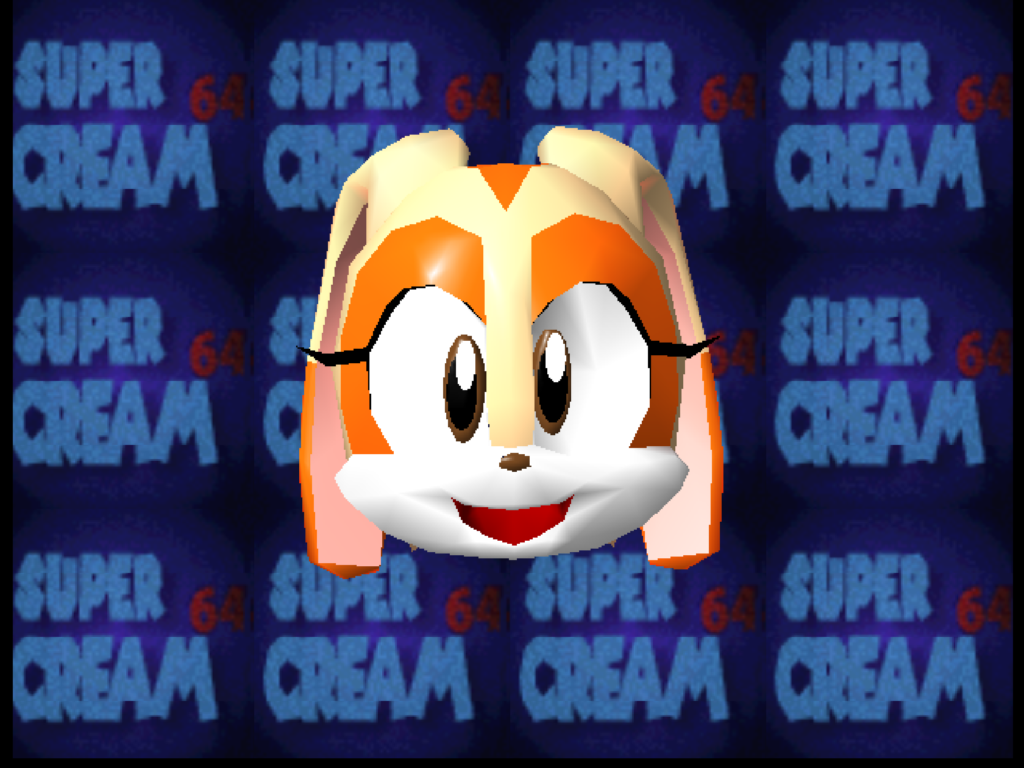
Saying that it’s a simple character swap is both dead accurate and wildly understating the effort that went into this. Nearly all the characters have new models, and there’s a few more in there as well. Mario has been replaced with Cream the Rabbit from (a couple of) the Sonic the Hedgehog games. Cream’s one of those characters that barely got any main game appearances before being relegated to the likes of guest roles in kart racers, so unless you’re as soaked in the deep Sonic lore, as I appear to be, you might never have heard of her, or Cheese, a Chao that follows her around (don’t ask me what a Chao is, I could tell you but the answer would probably not be useful to you) her mother Vanilla, or her friend Blaze the Cat, who are also in this hack. You may know of Amy Rose, who’s also here.
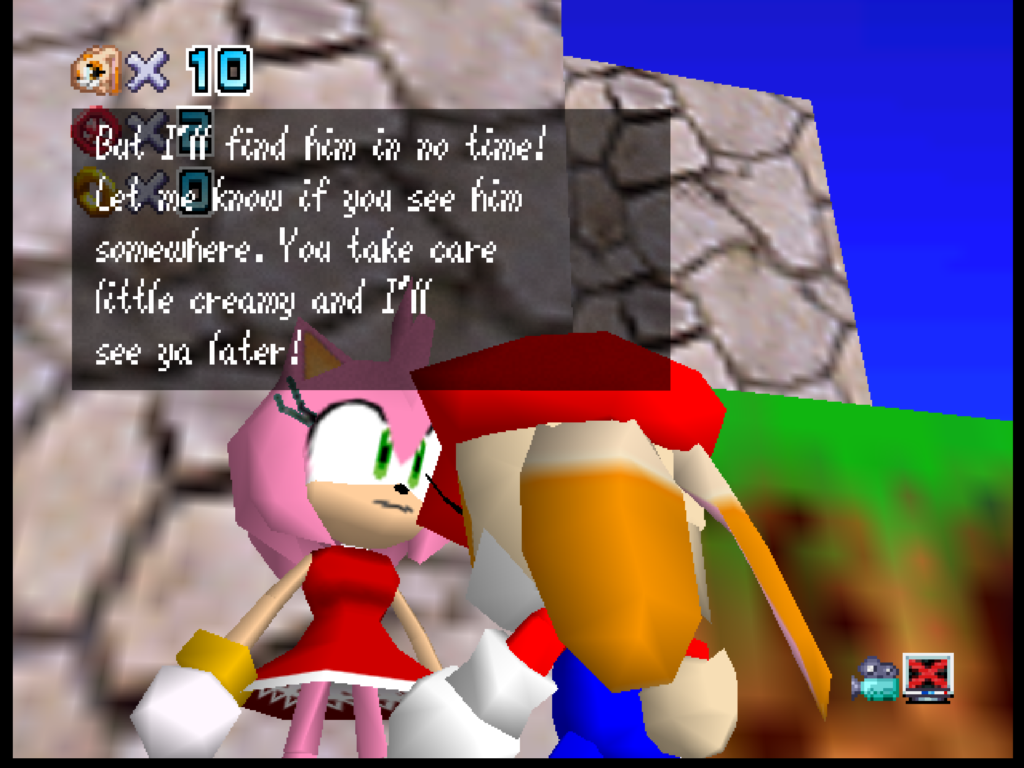
There are some play differences. Somehow Cream can fly, kind of, in a gliding sort of way, which makes the game a little bit easier. A small number of areas have been changed. But mostly this is a game for people who haven’t gotten their fill of Super Mario 64 already, and who want to play it as a different character. It’s almost as light and fluffy as its protagonist, but it’s evident that a lot of care has gone into it.
Here’s a bit of gameplay to show you what it’s about:
Super Cream 64 came to my attention when a friend was putting together a console-playable copy of it for her Sonic-obsessed kid. It’s amiable and mostly harmless. I can’t say it’s my usual kind of thing (the game itself really is mostly Mario 64, and Cream is a little too cutesy for me), but maybe it’s more to the taste of some of you out there?
This post started out being just about SC64, but here’s a couple of other character replacements that may be amusing, for a few minutes at least.
Excepting his appearances in Super Smash Bros. games, Captain Falcon is rarely playable on foot. Captain Falcon 64 suggests a run style and moveset that’s pretty much how one would imagine he’d play in an officially-made 3D platformer.
The logical intersection between Cream 64 and Falcon 64 would, of course, be Sonic 64. He’s even faster, and harder to control, than Captain Falcon. There are some gameplay changes here, including the ability to become Super Sonic, but I couldn’t tell you how. Maybe explore it yourself and see if you can figure it out.
Super Cream 64, by Gamebun (Sonic Fan Game HQ)
Captain Falcon 64, by PastaPower and Blakeoramo (SMW Central)
Super Mario 64: Sonic Edition, by Thodds (SMW Central)

“We scour the Earth web for indie, retro, and niche gaming news so you don’t have to, drebnar!” – your faithful reporter
My cell walls are feeling kind of rigid at the moment due to a computer issue that caused me to lose the first draft of this post. All of my witty remarks, lost to the electronic void. You missed out on my entertaining usage of the phrase “odoriferous blorpy.” Truly we are in the worst timeline. It’s all left me feeling kind of cranky, let’s get through it quickly this week.
Ted Litchfield at PC Gamer on a RuneScape player playing a minigame for eight years and turn turning in all his progress at once. RuneScape is an early MMORPG that began in 2001.
Several things to do with Konami, a once-great publisher that’s become pretty hidebound lately:
Dustin Bailey at GamesRadar: fans are working on a PC remake of Castlevania II: Simon’s Quest. I’m sure this won’t get obliterated by legal threats. They should have gone with the cheeky route taken by The Transylvania Adventure of Simon Quest. The article mentions that its creators consider the fact that many townsfolk lie to you to be a problem, instead of awesome as it really is.
Charles Harte at Gamespot organ Game Informer says Dead Cells’ upcoming Castlevania-themed DLC is really big.
Also from Charles Harte, Konami is shutting down their recently-released game CRIMESIGHT, not just removing it from the Steam store but even making it unplayable. Great way to reward people giving you money, K. It’s not even a year old yet!:
Tyler Wilde, also from PC Gamer, on a $2,000 game on Steam and what it’s about. Summarized: it costs $2,000 but is short enough that people can finish it within the return period, and it amounts to a screed against women. Blech!
Dean Howell at Neowin: a fan-made decompilation of The Legend of Zelda: A Link to the Past can now be compiled for Windows and (presumably if your device is jailbroken) Switch.
Christ Moyse at Destructoid tells us that Taito’s classic The New Zealand Story is coming to the Arcade Archives series. Gandalf could not be reached at press time for comment.
Two listicles:
Zoey Handley at Destructoid on the 10 best NES soundtracks. The list is Bucky O’Hare, Kirby’s Adventure, Castlevania 3 (Japanese version), Contra, Dr. Mario, Super Mario Bros. 2, Mega Man 2, Castlevania II, Journey to Silius, and… Silver Surfer?
Gavin Lane and the NintendoLife staff on the 50 best SNES games. The list is compiled algorithmically from reader scores, and can change even after publication. At this time, the top ten are, starting from $10: Donkey Kong Country 2, Earthbound, Teenage Mutant Ninja Turtles IV, Super Mario RPG, Yoshi’s Island, Final Fantasy III, Super Metroid, Chrono Trigger, Zelda: A Link to the Past and Super Mario World on top.
Tom Phillips at EuroGamer mentions that the original developers of Goldeneye 007, recently rereleased after 25 years on Switch and Xbox platforms, were a bit miffed that they weren’t asked to participate in the festivities. At the time most of its developers were completely new to the game industry, and they’ve been generally snubbed by its publishers in talking about the new versions. Does feel pretty shabby, Nintendo and Microsoft!
Andrew Liezewski at Gizmodo talks about the graphics in an upcoming Mario 64 hack made by Kaze Emanuar. I’ve followed Kaze’s hacking videos quite a bit (I think one’s been posted on Set Side B before), and the optimizations they’ve made to Mario 64’s engine are amazing, not only eliminating lag but great increasing its frame rate and making it look better to boot.
And, at Kotaku, Isaiah Colbert reports on various things being done to celebrate Final Fantasy VII’s 26th birthday, including official recognition in Japan of “Final Fantasy VII day” and a crossover with Power Wash Simulator. Maybe they can do something about cleaning out all the grunge from Midgar, that city could use a bath.
Found by MollyRealized over on Metafilter! It’s pretty much as the title says:
It’s now been some years since pannenkoek2012’s “A-button challenge” videos hit the scene, introducing the internet to hyper-obscure Super Mario 64 glitch concepts like the HOLP and Parallel Universes. For the record, those videos can be seen here and here, and if you haven’t seen them before, you are in for a ride. Videos like the Walls, Floors, and Ceilings series (37 minutes, 32 minutes and 37 minutes) are not only interesting in their own right (to people of a certain mindset) but are a good introduction to concepts for writing your own 3D platforming engine.
These videos are all ultimately in service to the A Button Challenge, a long-running quest to try to complete Super Mario 64 with a few presses of the A button as possible. What may seem like a completely spurious pastime, it turns out, has been an obsession with some players since not long after the game first came out!
The origins and history of the A Button Challenge are explained by a surprisingly long and deep series by YouTube user Bismuth, totaling over four hours of video and, as I write this, isn’t even complete. I’m not sure how many people would be interested in watching so much on such a niche endeavor, but pannenkoek’s videos have been popular enough that I figure they must be out there, and some of them may even read this blog, so here goes!